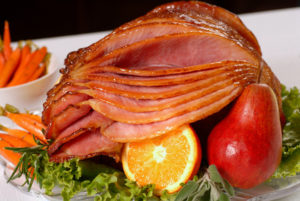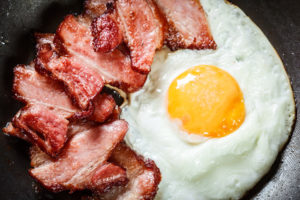
Welcome, Spring!
As we emerge from the bleak depths of winter, the arrival of spring brings with it budding flowers, greening grass, and the perfect occasion to eat one of our favorite meats…ham!
Ham is a great main course for entertaining and a classic choice for the Easter holiday.
Ham is also a versatile option in terms of preparation. You can glaze it, spiral slice it, smoke it, top it with mustard, or go full hog (sorry, couldn’t resist) and throw yourself an Easter pig roast. But more important than how you prepare or season your ham is the quality of the ham itself.
So let’s start with: What is ham? I mean, we all know what ham is. Who hasn’t had a ham sandwich at least once in their life? But how does ham become HAM?
Well, at Pasture Prime, ham starts out as pork from humanely handled and processed pigs who are never given any antibiotics or hormones.
Ham comes from a cured leg cut of pork. The curing process can be either wet or dry and is a way to both preserve the meat and increase its flavor. Dry curing uses a special salt rub, while wet curing uses water as a lubricating agent. The two most  common wet curing mixtures are brine (salt and water) and sweet pickle (salt, water, and sugar). You can also add additional flavorings, such as rosemary or garlic, to the mix before either injecting the ham with the mixture or submerging it for up to a week.
common wet curing mixtures are brine (salt and water) and sweet pickle (salt, water, and sugar). You can also add additional flavorings, such as rosemary or garlic, to the mix before either injecting the ham with the mixture or submerging it for up to a week.
The preservation process for ham can be so unique that many hams are “protected,” meaning that, depending on the jurisdiction, many hams cannot be labeled with the name of a particular style unless it actually came from that region (similar to how “real” champagne comes from the Champagne province of France).
Some examples include France’s Bayonne ham (slightly sweet with a chewy texture), the United Kingdom’s Wiltshire cure ham (originally a dry cure, since World War I, ham sourced from the UK has been wet cured by soaking in brine for 4-5 days), and Virginia’s Smithfield ham (ham that is finish-cured and aged for six months within the town borders of Smithfield, Virginia).

The preservation process for Black Forest ham can take up to three months, during which time the ham is salted and seasoned with garlic, coriander, pepper, and juniper berries, among other spices. The ham then cures for two weeks before the salt is removed and the ham ages for two more weeks. The ham is then cold-smoked.
Cold-smoking is done after meat has been fully cured and uses temperatures between 68 and 86 degrees Fahrenheit. Cold-smoking allows meat to take on that delicious, smoky flavor but still retain its moisture. The smokehouse can add additional flavor through the type of wood it uses for smoking. For Black Forest ham, smokehouses often use sawdust and fir or juniper brush. The ham will smoke for several weeks, turning nearly black on the outside, and then air-cures for an additional two weeks before it’s ready to be eaten.
Sound delicious?
We have it available! Check out this Berkshire Boneless Ham, smoked with Applewood, uncured (meaning no nitrates or nitrites were added through the use of a dry salt rub), and Black Forest style. We won’t say this ham will make the best ham sandwich you’ll ever eat in your life…but it will seriously make the best h

am sandwich you’ll ever eat in your life. This sale price won’t last long, so grab yours while we’ve got them!
For Easter dinner, you can’t go wrong with a spiral sliced ham. Fully cooked, easy to prepare, and able to be served at any temperature, spiral sliced hams are a host’s dream. Our Spiral Sliced Berkshire Hams are Applewood smoked and honey glazed, which adds a hint of sweetness that you and your guests will love. The only downside to serving this ham for Easter is that it’s so good you might not have any leftovers to enjoy the next day! But, don’t worry, as long as your guests leave you the bone, you have the perfect starter to whip up a pot of Green Split Pea with Ham Bone Soup or make your own bone broth.
Happy Spring!







